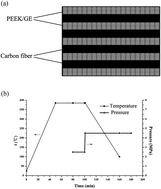Improvement of the thermal conductivity and friction performance of poly(ether ether ketone)/carbon fiber laminates by addition of graphene
Abstract
Poly(ether ether ketone)/graphene/carbon fiber (PEEK/GE/CF) laminates with different weight percentages of GE were manufactured successfully through ball milling and hot-press processing. The effect of the GE on the morphology, thermal conductivity, friction performance, thermal and mechanical properties of composites was investigated. Scanning electron microscopy showed that the GE was uniformly distributed in matrix-rich regions. Thermal conductivity measurements demonstrated that addition of 0.7 wt% GE sharply improved the thermal conductivity of the laminates. Tribological tests revealed that the friction coefficient and wear rate rapidly decreased with the addition of GE. In the studied range, the friction reduction and wear resistance performance of PEEK/CF composites filled with 0.7 wt% GE is the most effective. Meanwhile, the obtained PEEK/GE/CF laminates also possessed excellent mechanical and thermal properties. Thus, graphene-reinforced PEEK/CF composites possessed better overall properties than conventional PEEK/CF composites.


 Please wait while we load your content...
Please wait while we load your content...